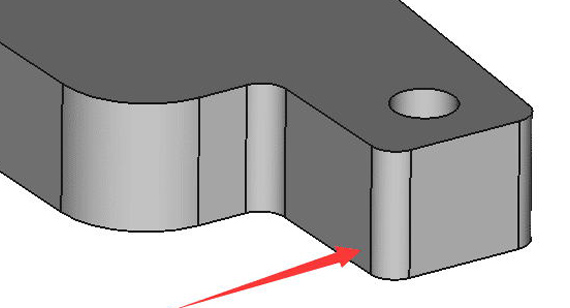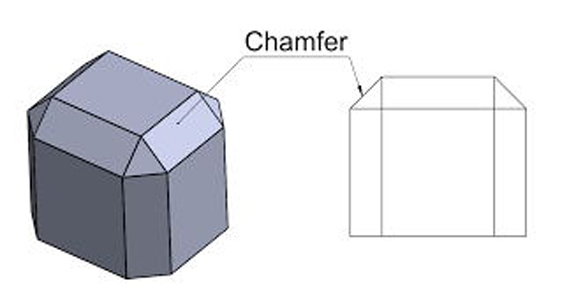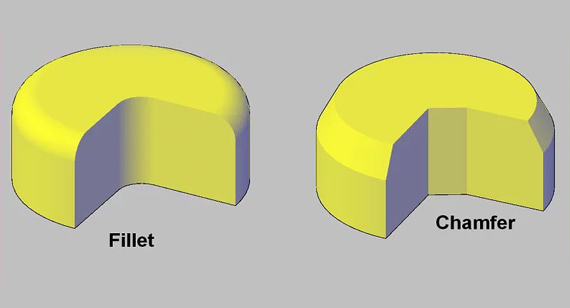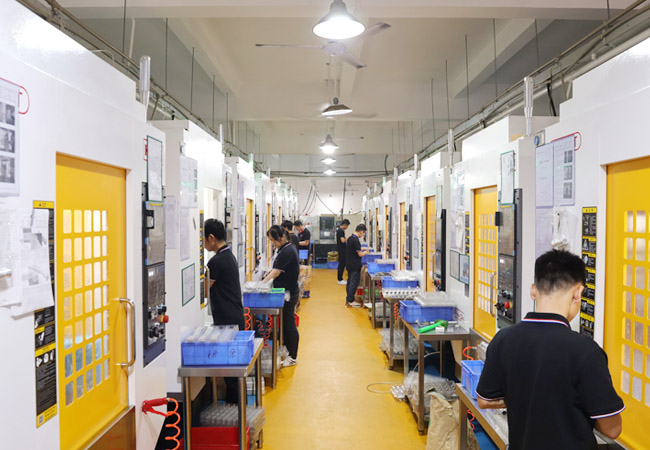VMT’s blogs aim to share our practical experience and knowledge accumulated during the manufacturing and product development process. Our goal is to use these articles to help you improve product design and increase your understanding of CNC machining, 3D printing, rapid prototyping, low-volume manufacturing, and surface treatment technologies. The information we provide is designed to provide actionable guidance and insights for your CNC machining projects.
The Difference Between Rounded Corners and Chamfer: A Fine Distinction in CNC Machining
Rounded corners and chamfers are essential detail processing techniques in CNC machining, which not only affect the appearance of the product, but also directly affect the structural strength, assembly performance and smoothness of subsequent machining. For manufacturers of CNC machining services, a deep understanding of the difference between fillets and chamfers is a core element to improve machining accuracy and optimize product design solutions.
What is Rounded Corners?
A rounded corner is a rounded corner or edge, often used to smooth out sharp transitions in a design. In CNC machining, common methods include milling, turning, and wire cutting, which can accurately produce fillets. The main purpose of a rounded corner is to reduce stress concentrations in a mechanical component, which helps prevent cracking and wear. Fillets are often found in objects where smooth, rounded edges are both practical and aesthetically pleasing, such as product housings or mechanical gears.

What are the Advantages of Rounded Corners?
Stress dispersion: It can effectively reduce stress concentration at the edges of mechanical parts, enhance the strength and durability of parts, and avoid breakage in high-stress environments.
Improved safety: The rounded corner design eliminates sharp corners, reduces the potential risk of harm to the human body and the surrounding environment, and improves the overall safety of the product.
Beautify the appearance: rounded corners give the product rounded and smooth lines, making the appearance more harmonious and beautiful, and enhancing the visual appeal of the product.
Simplified manufacturing: During machining, rounded edges are easier to handle, making machining easier and more cost-effective, while also reducing tool wear.
Optimized assembly: Rounded corners help reduce friction and interference between parts, promote a smooth assembly process, and improve assembly efficiency and convenience, especially in equipment that requires frequent disassembly and assembly.
What is A Chamfer?
A chamfer is a beveled edge, often found at 45 or 60-degree angles, that replaces a sharp 90 degree angle with an inclined surface. Chamfers are often used to simplify assembly, prevent edge damage, or improve the appearance of a product by adding smooth, angular details. In part design, a chamfer is considered an inclined or angled edge treatment, in contrast to a fillet, as it is not a curved shape, but a straight line with a sharp angle.

Is Chamfering Cheaper than Rounding?
From the perspective of processing cost, chamfering is usually cheaper than rounding because it requires relatively less cutting, the processing steps are relatively simple, and there is no need to shape a complete arc shape. However, the specific cost difference depends on comprehensive factors such as the geometry, size, material used and selected processing technology of the part.
Why Design Parts Using Rounded Corners and Chamfers?
Security:
Incorporating rounded corners and chamfers into part design is primarily to reduce the sharpness of edges, significantly reducing the risk of scratches or punctures caused by sharp edges.
Process Optimization:
In part design, the use of rounded corners and chamfers not only significantly improves the surface quality, but also effectively improves the surface finish of parts by removing burrs and sharp edges generated during the processing, thereby improving the overall process quality. At the same time, this design strategy also has the function of stress dispersion, which can even out the stress at the edge and effectively prevent damage caused by excessive local stress, thereby enhancing the durability of parts and long-term operation stability. Especially in certain specific manufacturing processes, such as CNC machining, fillet and chamfer design simplifies the machining process and reduces technical difficulty and cost.
Ease of Assembly:
Rounded corner and chamfer design plays a natural guiding role in parts assembly. As a smooth assembly guide, they ensure a seamless connection between parts, especially when the shaft and hole are matched, greatly improving the smoothness and efficiency of the assembly process. At the same time, in complex assembly structures, these carefully designed rounded corners and chamfers can effectively avoid direct collisions and jams between sharp corners, thereby ensuring the smooth progress of the assembly process and reducing assembly difficulty and time costs.
Aesthetics:
Rounded corners and chamfers give the product softer and smoother lines, improving the overall aesthetics of the product. At the same time, as one of the design elements, they enhance the product’s visual appeal and user favorability.
When is a Rounded Corner or Chamfer Necessary?

When to Use Rounded Corners:
High-stress bearing parts: When parts need to withstand high stress, the use of rounded corners can more effectively disperse stress concentration points, significantly reduce the risk of cracking or damage, and enhance the strength and durability of parts.
Aesthetic enhancement: In product design, rounded corners can give more rounded and smoother lines, enhancing the overall beauty and appeal of the product. This is especially important for consumer-oriented products that focus on appearance.
When to Use Chamfer:
Low-stress parts: For parts that are subjected to less stress and do not require high strength, chamfering is an economical and effective edge machining method that can remove burrs, improve appearance, and reduce processing costs.
Facilitate assembly: Among the parts that need to be assembled together, chamfering can ensure the smooth progress of the assembly process, reduce the friction and resistance between parts, and improve assembly efficiency and quality.
Cost control: In mass production scenarios, chamfering becomes an effective means to reduce overall production costs due to its simple processing and low cost.
Difference Between Rounded Corners and Chamfer.
Definition:
A rounded corner is defined by introducing a circular curve that bends inwards at the edge of an object. This design gives the edge a smooth and soft touch, completely eliminating the sense of sharpness. Chamfering involves creating a curve that bends outwards at the edge of an object, or cutting an inner or outer bevel at a certain angle at the corner. Compared with a rounded corner, a chamfer is more visually defined and adds a sense of layering to the edge.
Application Areas:
Rounded corners reduce sharp edges and reduce the risk of collision injury, making them ideal for children’s furniture and kitchen utensils. At the same time, they enhance grip comfort and stability, which is particularly important in the design of some handheld devices.
Chamfering enhances structural stability and compressive strength, reduces stress concentration, and is commonly used in mechanical engineering and product design. It also gives objects a more distinct outline and three-dimensional sense, showing a unique charm in architectural design, furniture design and jewelry design.
Machining Technology:
A rounded Corner requires precise cutting of the edge to form a circular arc tangent to both sides, the size of which is clearly indicated by the radius of the arc. Chamfering, on the other hand, involves cutting a slope of a specified angle, the size of which can be expressed by the length of the slope projected on the vertical and horizontal planes or the slope angle.
Application Comparison:
Rounded corner performs well in optimizing stress distribution and enhancing aesthetics; chamfer is more suitable for deburring, facilitating assembly and controlling costs.
Aesthetics:
Rounded corners give a rounded and soft beauty, while chamfers show clean lines.
Manufacturability and Cost:
Chamfering is relatively simple and inexpensive, while rounding can be more complex and time-consuming, especially when high precision is required.
Stress Concentration:
Rounded corners significantly reduce stress concentration and improve product durability; although chamfers have a certain effect, it is relatively limited.
Machining Time and Complexity:
Filleting takes more time, especially in complex shapes; chamfering is generally more direct and efficient.
Cutting Tools:
Filleting requires special forming tools, which are more expensive; chamfering can use standard or forming tools, which is more economical.
Coating Influence:
The smooth surface of the rounded corners is conducive to coating adhesion and uniformity, while the chamfered surface may affect the coating effect due to the inclination angle.
| Differences | Rounded Corners | Chamfer |
| definition | Introducing inward curved rounded curves at the edges of objects, with smooth and soft edges | Create outward curved lines on the edge of an object or cut out inner/outer bevels at a certain angle, giving the edge a strong sense of layering |
| Reduce damage | Complete elimination of sharp edges, significantly reducing the risk of scratches | Blunted edges, reducing the risk of scratches (but still a slight possibility) |
| Machining Technology | Precision cutting edges form arcs, the size of which is indicated by the arc radius | Cut a bevel of a specified angle, the size of which is indicated by the projected length or inclination angle |
| Application Comparison | Optimized stress distribution and enhanced aesthetics | Deburring, facilitating assembly and controlling costs |
| Aesthetics | Round and soft beauty | Clean lines |
| Manufacturability and cost | The processing is complicated and time-consuming, especially under high precision requirements; the cost is high | Simple processing and low cost |
| Stress Concentration | Significantly reduce stress concentration and improve product durability | There is some effect, but it is relatively limited |
| Machining time and complexity | Long processing time, especially for complex shapes | The processing is direct, efficient and relatively simple |
| Cutting Tools | Requires special forming tool, which is more expensive | Economical use of standard or profiled tools |
| Coating Effect | A smooth surface facilitates coating adhesion and uniformity | Tilt angle may affect the coating effect |
Start Your CNC Machining Project at VMT
At VMT, you can start your CNC machining project and use our high-precision, high-efficiency CNC machine tools and 12-step quality inspection process to ensure the accuracy and cost control of the machining process to meet your various customized needs.
Choose VMT for reliable, ISO 9001 & IATF 16949 certified CNC machining services, fast turnaround times, and competitive pricing. Contact us today to get a quote!

In Conclusion
As important detail machining processes in CNC machining, rounded corners and chamfering have a significant impact on the overall performance and quality of the product. The choice of rounded corners or chamfering requires a comprehensive evaluation based on specific applications and requirements. Rounded corners design can usually improve the safety and aesthetics of the product and reduce the damage that may be caused by sharp edges. However, this design often requires higher machining precision and may increase costs.
In contrast, chamfer design is more economical and practical, suitable for mass production and rapid machining. It can remove burrs on the edge and improve assembly performance.
Frequently Asked Questions About Rounded Corners and Chamfer
Are Rounded Corners Stronger than Chamfers?
Rounded corners are generally more effective than chamfers in reducing stress concentrations, which in turn effectively reduces the risk of cracks or fractures under stress. Therefore, in applications that require high stress tolerance or are subject to dynamic loads, rounded edge designs are often seen as a more robust option.
Are Rounded Corners the Same as Beveled Corners?
There is a difference between rounded corners and bevels. A rounded corner is an edge treatment that aims to improve the appearance and performance of a part by rounding the edge to eliminate sharp corners. Bevels are usually done by cutting a bevel on the edge that forms an acute or obtuse angle with the body of the part.



